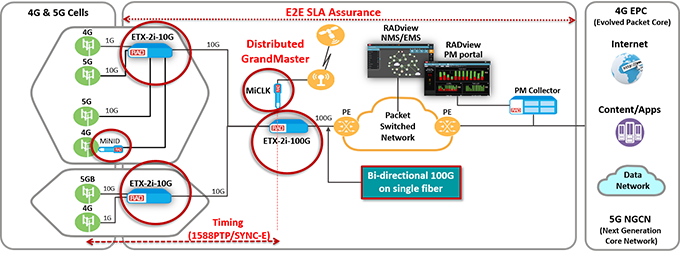
Your Network's Edge®
Blog Post
You are here
xHaul Deployment Strategies of 5G Early Adopters
As we announced last week, tier-1 service providers in Europe are already using RAD’s ETX-2i-10G cell site gateway for initial 5G rollouts. This might seem surprising, considering that 5G standards haven’t been finalized yet. In this case, while operators are still formalizing their plans, they also face an immense pressure to make an early market impact and cash in on the 5G buzz. To do that, they adopt a phased deployment strategy:
Initial Step – Capacity and Densification:
First, some CSPs opt to enable high-rate enhanced Mobile Broadband (eMBB) services by focusing on capacity increase in their transport networks and on cell site densification. This is achieved by adding capabilities, such as:
- High-speed pipes for all RAN transport (10G, nx10G, 100G)
- Enhanced Timing synchronization
- xHaul assurance (delay, jitter)
The common view today is that 5G and 4G will co-exist in the foreseeable future, and 4G enhancements are expected to continue in parallel to the 5G evolution. In other words, CSPs are looking at multi-generation networks.
As can be seen in the diagram below, to achieve these objectives, our customers are using the ETX-2i 10G cell site gateways/aggregators and 100G aggregators, the MiCLK distributed Grandmaster to ensure sub-millisecond latency, end-to-end performance monitoring for xHaul assurance and the RADview management and orchestration system to facilitate, among others, the download of hardware microservices to the ETX-2i products.

5G xHaul deployment, phase 1: Solve capacity and densification issues
Next Steps – xHaul Enhancements:
As 5G standards solidify, CSPs will focus on segment routing and on enabling highly distributed content and applications with multiple classes of service for various end-to-end 5G slices. They’d also look into delivering bi-directional 100G traffic over a single fiber to reduce costs.
So the challenge for mobile operators is to define an effective migration path for their existing mobile backhaul networks so that they have a clear plan to address new requirements for capacity, densification, topology, distributed functionality, and more.
RAD’s ETX-2i future-proof cell site gateways allow such flexibility in adapting to evolving xHaul needs. It offers an open firmware that can be easily field-modified to meet unique 5G requirements as they are being defined and standardized. This includes SDN-related capabilities to bring carrier-grade distributed compute power for multi-access edge computing (MEC) applications, as well as highly accurate Timing distribution for 5G synchronization, redundancy/backup, enhanced performance monitoring to assure ultra-low latency, and advanced traffic classification for end-to-end network slicing. Add to that dynamic on-demand connectivity and you get all the xHaul groundwork for CSPs to make the leap forward to 5G.
Visiting MWC this year? Make sure to stop by the RAD booth. We’d love to talk to you some more about our experience with early 5G xHaul deployments.
About RAD's Blog
We’ll be blogging on a wide range of hot topics affecting service providers and critical infrastructure network operators. Our resident experts will be discussing vCPE, Cyber Security, 5G, Industrial IoT and much, much more.

